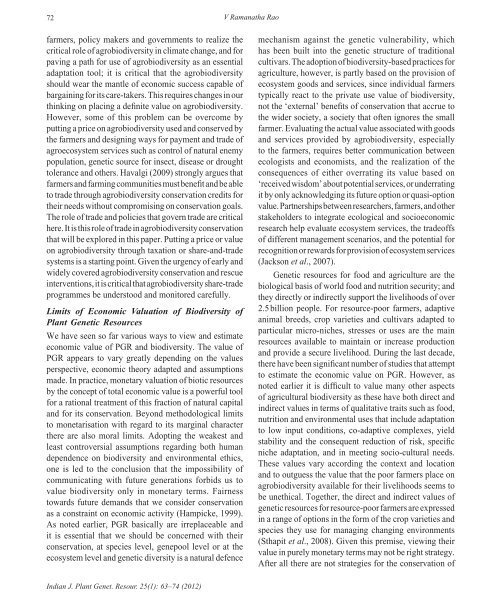indian society of plant genetic resources - Bioversity International
indian society of plant genetic resources - Bioversity International
indian society of plant genetic resources - Bioversity International
Create successful ePaper yourself
Turn your PDF publications into a flip-book with our unique Google optimized e-Paper software.
72<br />
farmers, policy makers and governments to realize the<br />
critical role <strong>of</strong> agrobiodiversity in climate change, and for<br />
paving a path for use <strong>of</strong> agrobiodiversity as an essential<br />
adaptation tool; it is critical that the agrobiodiversity<br />
should wear the mantle <strong>of</strong> economic success capable <strong>of</strong><br />
bargaining for its care-takers. This requires changes in our<br />
thinking on placing a defi nite value on agrobiodiversity.<br />
However, some <strong>of</strong> this problem can be overcome by<br />
putting a price on agrobiodiversity used and conserved by<br />
the farmers and designing ways for payment and trade <strong>of</strong><br />
agroecosystem services such as control <strong>of</strong> natural enemy<br />
population, <strong>genetic</strong> source for insect, disease or drought<br />
tolerance and others. Havalgi (2009) strongly argues that<br />
farmers and farming communities must benefi t and be able<br />
to trade through agrobiodiversity conservation credits for<br />
their needs without compromising on conservation goals.<br />
The role <strong>of</strong> trade and policies that govern trade are critical<br />
here. It is this role <strong>of</strong> trade in agrobiodiversity conservation<br />
that will be explored in this paper. Putting a price or value<br />
on agrobiodiversity through taxation or share-and-trade<br />
systems is a starting point. Given the urgency <strong>of</strong> early and<br />
widely covered agrobiodiversity conservation and rescue<br />
interventions, it is critical that agrobiodiversity share-trade<br />
programmes be understood and monitored carefully.<br />
Limits <strong>of</strong> Economic Valuation <strong>of</strong> Biodiversity <strong>of</strong><br />
Plant Genetic Resources<br />
We have seen so far various ways to view and estimate<br />
economic value <strong>of</strong> PGR and biodiversity. The value <strong>of</strong><br />
PGR appears to vary greatly depending on the values<br />
perspective, economic theory adapted and assumptions<br />
made. In practice, monetary valuation <strong>of</strong> biotic <strong>resources</strong><br />
by the concept <strong>of</strong> total economic value is a powerful tool<br />
for a rational treatment <strong>of</strong> this fraction <strong>of</strong> natural capital<br />
and for its conservation. Beyond methodological limits<br />
to monetarisation with regard to its marginal character<br />
there are also moral limits. Adopting the weakest and<br />
least controversial assumptions regarding both human<br />
dependence on biodiversity and environmental ethics,<br />
one is led to the conclusion that the impossibility <strong>of</strong><br />
communicating with future generations forbids us to<br />
value biodiversity only in monetary terms. Fairness<br />
towards future demands that we consider conservation<br />
as a constraint on economic activity (Hampicke, 1999).<br />
As noted earlier, PGR basically are irreplaceable and<br />
it is essential that we should be concerned with their<br />
conservation, at species level, genepool level or at the<br />
ecosystem level and <strong>genetic</strong> diversity is a natural defence<br />
Indian J. Plant Genet. Resour. 25(1): 63–74 (2012)<br />
V Ramanatha Rao<br />
mechanism against the <strong>genetic</strong> vulnerability, which<br />
has been built into the <strong>genetic</strong> structure <strong>of</strong> traditional<br />
cultivars. The adoption <strong>of</strong> biodiversity-based practices for<br />
agriculture, however, is partly based on the provision <strong>of</strong><br />
ecosystem goods and services, since individual farmers<br />
typically react to the private use value <strong>of</strong> biodiversity,<br />
not the ‘external’ benefi ts <strong>of</strong> conservation that accrue to<br />
the wider <strong>society</strong>, a <strong>society</strong> that <strong>of</strong>ten ignores the small<br />
farmer. Evaluating the actual value associated with goods<br />
and services provided by agrobiodiversity, especially<br />
to the farmers, requires better communication between<br />
ecologists and economists, and the realization <strong>of</strong> the<br />
consequences <strong>of</strong> either overrating its value based on<br />
‘received wisdom’ about potential services, or underrating<br />
it by only acknowledging its future option or quasi-option<br />
value. Partnerships between researchers, farmers, and other<br />
stakeholders to integrate ecological and socioeconomic<br />
research help evaluate ecosystem services, the trade<strong>of</strong>fs<br />
<strong>of</strong> different management scenarios, and the potential for<br />
recognition or rewards for provision <strong>of</strong> ecosystem services<br />
(Jackson et al., 2007).<br />
Genetic <strong>resources</strong> for food and agriculture are the<br />
biological basis <strong>of</strong> world food and nutrition security; and<br />
they directly or indirectly support the livelihoods <strong>of</strong> over<br />
2.5 billion people. For resource-poor farmers, adaptive<br />
animal breeds, crop varieties and cultivars adapted to<br />
particular micro-niches, stresses or uses are the main<br />
<strong>resources</strong> available to maintain or increase production<br />
and provide a secure livelihood. During the last decade,<br />
there have been signifi cant number <strong>of</strong> studies that attempt<br />
to estimate the economic value on PGR. However, as<br />
noted earlier it is diffi cult to value many other aspects<br />
<strong>of</strong> agricultural biodiversity as these have both direct and<br />
indirect values in terms <strong>of</strong> qualitative traits such as food,<br />
nutrition and environmental uses that include adaptation<br />
to low input conditions, co-adaptive complexes, yield<br />
stability and the consequent reduction <strong>of</strong> risk, specifi c<br />
niche adaptation, and in meeting socio-cultural needs.<br />
These values vary according the context and location<br />
and to outguess the value that the poor farmers place on<br />
agrobiodiversity available for their livelihoods seems to<br />
be unethical. Together, the direct and indirect values <strong>of</strong><br />
<strong>genetic</strong> <strong>resources</strong> for resource-poor farmers are expressed<br />
in a range <strong>of</strong> options in the form <strong>of</strong> the crop varieties and<br />
species they use for managing changing environments<br />
(Sthapit et al., 2008). Given this premise, viewing their<br />
value in purely monetary terms may not be right strategy.<br />
After all there are not strategies for the conservation <strong>of</strong>

















